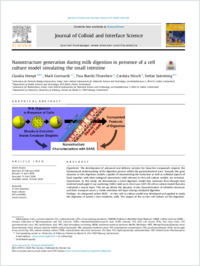Nanostructure generation during milk digestion in presence of a cell culture model simulating the small intestine
- Hempt, Claudia Laboratory for Particles-Biology Interactions, Empa, Swiss Federal Laboratories for Materials Science and Technology, Lerchenfeldstrasse 5, 9014 St. Gallen, Switzerland - Department of Health Sciences and Technology, ETH Zürich, Zürich, Switzerland
- Gontsarik, Mark Laboratory for Biointerfaces, Empa, Swiss Federal Laboratories for Materials Science and Technology, Lerchenfeldstrasse 5, 9014 St. Gallen, Switzerland
- Buerki-Thurnherr, Tina Laboratory for Particles-Biology Interactions, Empa, Swiss Federal Laboratories for Materials Science and Technology, Lerchenfeldstrasse 5, 9014 St. Gallen, Switzerland
- Hirsch, Cordula Laboratory for Particles-Biology Interactions, Empa, Swiss Federal Laboratories for Materials Science and Technology, Lerchenfeldstrasse 5, 9014 St. Gallen, Switzerland
- Salentinig, Stefan Department of Chemistry, University of Fribourg, Chemin du Musée 9, 1700 Fribourg, Switzerland
-
15.08.2020
Published in:
- Journal of Colloid and Interface Science. - 2020, vol. 574, p. 430–440
English
Hypothesis: The development of advanced oral delivery systems for bioactive compounds requires the fundamental understanding of the digestion process within the gastrointestinal tract. Towards this goal, dynamic invitro digestion models, capable of characterising the molecular as well as colloidal aspects of food, together with their biological interactions with relevant invitro cell culture models, are essential.Experiments: In this study, we demonstrate a novel digestion model that combines flow-through time resolved small angle X-ray scattering (SAXS) with an invitro Caco-2/HT-29 cell co-culture model that also contained a mucus layer. This set- up allows the dynamic insitu characterisation of colloidal structures and their transport across a viable intestinal cell layer during simulated digestion.Findings: An integrated online SAXS – invitro cell co-culture model was developed and applied to study the digestion of nature’s own emulsion, milk. The impact of the invitro cell culture on the digestion-triggered formation and evolution of highly ordered nanostructures in milk is demonstrated. Reported is also the crucial role of the mucus layer on top of the cell layer, protecting the cells from degradation by digestive juice components such as lipase. The novel model can open unique possibilities for the dynamic investigation of colloidal structure formation during lipid digestion and their effect on the uptake of bioactive molecules by the cells.
- Faculty
- Faculté des sciences et de médecine
- Department
- Département de Chimie
- Language
-
- English
- Classification
- Chemistry
- License
- License undefined
- Identifiers
-
- RERO DOC 328628
- DOI 10.1016/j.jcis.2020.04.059
- Persistent URL
- https://folia.unifr.ch/unifr/documents/308735
Other files
Statistics
Document views: 87
File downloads:
- sal_ngd.pdf: 190
- sal_ngd_sm.pdf: 100

